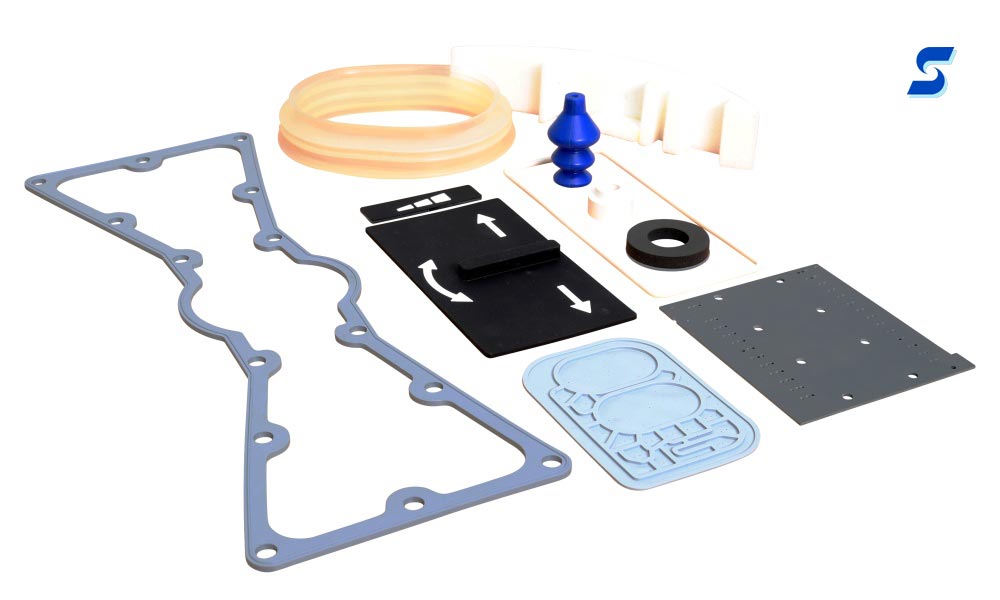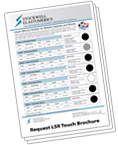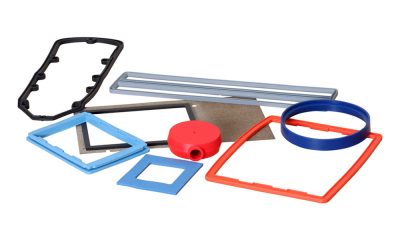Material
Liquid Silicone Rubber
Moldable 2-part silicone with versatility to serve a variety of applications
Moldable 2-part silicone with versatility to serve a variety of applications

Stockwell Elastomerics applies acrylic pressure sensitive adhesives onto LSR sheets and rolls for adhesive backed gaskets. One of Stockwell Elastomerics’ specialties is applying film supported acrylic adhesives, such as 3M 9415 or Adchem 256M and 3M 467 transfer film adhesive onto .010″ and .020″ thick cast liquid silicone rubber for display gaskets and similar applications requiring a very thin gasket.
Stockwell Elastomerics also injection molds custom 3D parts per customer specifications. LSRs have a wide temperature range (-58°F to 392°F) and can be made in wide durometer range (10 – 80 Shore A) without plasticizers. Silicone’s excellent rebound, UV and ozone resistance makes it ideal for outdoor sealing and can be use for submerged gaskets (IP67 and NEMA 6). Stockwell Elastomerics maintains in-house inventory of silicone sheet, silicone rolls and molding compounds to be injection molded for fast response times.

Includes small samples of cured LSR materials to touch and feel.
Liquid silicone rubber (LSR) is very low viscosity silicone that can be injection molded or cast into silicone rubber sheets. “Liquid” is explicit in the name to differentiate LSRs from high consistency gum based silicone products. LSRs are addition cure / platinum cure systems in contrast with most gum based silicones that are peroxide cured. In its raw uncured form, LSR is two parts liquid that are mixed together (mixing of Part A and Part B starts the curing) and heated to accelerate the curing process. Raw gum based silicones look and feel similar to clay. LSRs are generally injection molded or cast while gum based silicones are typically compression molded. Note that injection molding of liquid silicone rubber is the inverse of molding thermoplastics; room temperature liquid silicone compound is injected into and cured in a hot mold vs. plastic pellets melted into hot liquid and forced into a cooled mold.
![]() Performance properties and fast cure cycles make liquid silicone rubber a good choice for small molded components. Unlike most thermoplastic elastomers (TPRs and TPEs), LSR remains flexible and elastic down to -58°F and retains its properties up to 392°F. Liquid silicone rubber is a good candidate for gaskets, seals and cushioning pads in portable communications, data acquisition instruments and ruggedized electronic devices where outdoor conditions are demanding. The cure cycles in liquid injection molding allow for a 1 or 2 cavity mold to out-produce a compression mold with a higher cavity count.
Performance properties and fast cure cycles make liquid silicone rubber a good choice for small molded components. Unlike most thermoplastic elastomers (TPRs and TPEs), LSR remains flexible and elastic down to -58°F and retains its properties up to 392°F. Liquid silicone rubber is a good candidate for gaskets, seals and cushioning pads in portable communications, data acquisition instruments and ruggedized electronic devices where outdoor conditions are demanding. The cure cycles in liquid injection molding allow for a 1 or 2 cavity mold to out-produce a compression mold with a higher cavity count.
Beyond the mechanical, chemical, and thermal properties of LSR, there are numerous other reasons to specify this type of material. From a manufacturability standpoint, a few key factors stand out. One of the biggest reasons that customers may end up going with LSR material is geometry. Any sort of 3D shape that cannot be fabricated in a flat configuration would require a molding process – usually with parts like this, a high production quantity level justifies the added cost of tooling that is associated with LSR molding.
Additionally, some customers may have flat gaskets, but with very tight thickness tolerance needs. In these cases, Stockwell Elastomerics can leverage its sheet molding capabilities to hold tighter tolerances in small sheets, which can then be used to die-cut or waterjet cut flat gaskets and pads.
On occasion, customers want to transition from flat cut parts to molded components. As customers work through small prototype runs of initial designs, Stockwell Elastomerics supports this change with quick turn waterjet cut gaskets using molded LSR sheets. As designs develop and molding is required, the same material can be utilized. This eliminates re-testing and re-validation, since the material is the exact same for the prototypes and production parts.
For parts without any sort of 3D geometry, molding can be a very cost effective solution at high quantity production, as traditional die-cutting and waterjet cutting have wasted material cost. For example, a small window gasket may be quite cost effective to provide in small quantities as a waterjet cut part, but as production quantities increase, the combined cost of the wasted window cutout can add up. In cases like this, paying to tool-up a production LSR mold creates a much more cost-effective solution trimmed piece price down the line.
In LSR materials, a catalyst is required as part of the curing process. Common cure catalysts are tin (also known as condensation cure) and platinum (also known as addition cure). All of Stockwell Elastomerics’ LSR products are platinum-cured.
Platinum-cured LSR is typically “cleaner” than tin-cured LSR – this is why many of Stockwell Elastomerics’ LSR products are suitable to be used in the medical device industry. Platinum-cured LSR is often capable of meeting FDA and USP Class VI certifications. Platinum-cured LSR can also survive higher temperatures when compared to tin-cured alternatives.
Tin-cured LSR is usually found in consumer and inventor-grade material. This material can cure using condensation from the air and does not require heat. Tin-cured LSR is typically not FDA grade and is not used in more demanding applications.
While tin-cured LSR is more accessible for hobby-grade and various consumer applications, it does not offer some of the distinct advantages and high-performance characteristics of platinum-cured LSR. This is why platinum-cured LSRs used exclusively – these materials best serve customers in core industries served by Stockwell Elastomerics.
LSR is available in a hardness range of 10 to 80 durometer Shore A. 10 durometer LSR is very soft like chewing gum and can feel softer than some extra firm silicone foam and silicone sponge products. 80 durometer LSR is harder than a heel of a shoe and is as firm as many thermoplastic elastomer products. Most applications for LSR are specified in the 20 to 60 durometer Shore A range.
Stockwell Elastomerics’ Liquid Silicone Rubber Touch Brochure can assist with selection of material hardness for specific applications. The tensile, elongation and tear resistance properties of liquid silicones have improved since the initial commercialization of LSR.
Stockwell Elastomerics offers off-the-shelf LSR sheets (12″ x 12″) and continuous cast rolls with or without film supported acrylic or acrylic transfer film adhesive options. The 12″ x 12″ molded sheets are available from .032″ to .125″ thick. Stockwell Elastomerics’ on-site molding facility provides molded and cryogenically deflashed, custom liquid silicone gaskets and a variety of custom components.

Although liquid silicon rubber is called out sometimes called out in specifications, liquid silicone rubber is the widely accepted terminology used in the rubber industry.

Includes small samples of cured LSR materials to touch and feel.
Contact Us for further assistance with LSR materials for molded parts, silicone sheets and rolls.